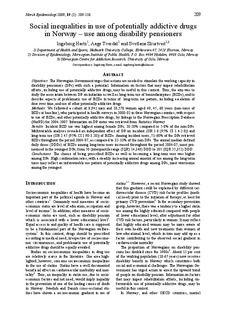Social inequalities in use of potentially addictive drugs in Norway - use among disability pensioners
Journal article, Peer reviewed
Permanent lenke
http://hdl.handle.net/11250/134206Utgivelsesdato
2009Metadata
Vis full innførselSamlinger
Originalversjon
Hartz, I, Tverdal, A & Skurtveit, S (2009) Social inequalities in use of potentially addictive drugs in Norway - use among disability pensioners, Norsk Epidemiologi 19(2), 209-218.Sammendrag
Objectives: The Norwegian Government urges that actions are needed to stimulate the working capacity in disability pensioners (DPs) with such a potential. Information on factors that may impair rehabilitation efforts, including use of potentially addictive drugs, may be useful in this context. Thus, the aim was to study the association between DP on initiation as well as long-term use of benzodiazepines (BZDs), and to describe aspects of problematic use of BZDs in terms of: long-term use pattern, including escalation of dose over time, and use of other potentially addictive drugs.
Methods: We followed a cohort of 8,942 men and 10,578 women aged 40, 45, 60 years (non-users of BZDs at baseline), who participated in health surveys in 2000-01 in three Norwegian counties, with respect to use of BZDs, and other potentially addictive drugs, by linkage to the Norwegian Prescription Database (NorPD) for 2004-2007. Information on DP status was retrieved from Statistics Norway.
Results: Incident BZD use was highest among female DPs; 18-20% compared to 5-8% of the non-DPs. Multivariable analyses revealed an independent effect of DP on incident (OR 1.6 (95% CI 1.4-2.0)) and long-term use (OR 2.47 (95% CI 1.90-3.20)) of BZDs. Among incident users, 51-60% of the DPs retrieved BZDs throughout the period 2004-07, as compared to 32-33% of the non-DPs. The annual median defined daily doses (DDDs) of BZDs among long-term users increased throughout the period 2004-07, most pronounced in the youngest DPs; from 50 (interquartile range (IQR) 14,140) DDD to 205 (IQR 25,352) DDD.
Conclusions: The chance of being prescribed BZDs as well as becoming a long-term user was higher among DPs. High continuation rates, with a steadily increasing annual amount of use among the long term users may reflect an unfavourable use pattern of potentially addictive drugs among DPs, most worrisome among the youngest.
Beskrivelse
The original publication is available at: http://www.ntnu.no/ojs/index.php/norepid/article/viewFile/592/558
